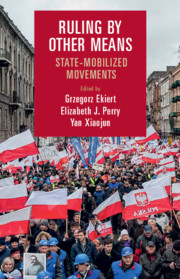Book contents
- Ruling by Other Means
- Cambridge Studies in Contentious Politics
- Ruling by Other Means
- Copyright page
- Contents
- Figures
- Tables
- Contributors
- Acknowledgments
- 1 State-Mobilized Movements: A Research Agenda
- 2 Manufactured Ambiguity
- 3 Suppressing Students in the People’s Republic of China
- 4 State-Mobilized Community Development
- 5 Enforcement Networks and Racial Contention in Civil Rights–Era Mississippi
- 6 Social Sources of Counterrevolution
- 7 Occupy Youth!
- 8 State-Mobilized Movements after Annexation of Crimea
- 9 Mirroring Opposition Threats
- 10 Mobilizing against Change
- 11 The Dynamics of State-Mobilized Movements
- 12 State-Mobilized Campaign and the Prodemocracy Movement in Hong Kong, 2013–2015
- 13 The Resurrection of Lei Feng
- Index
- Books in the Series (continued from p.iii)
- References
12 - State-Mobilized Campaign and the Prodemocracy Movement in Hong Kong, 2013–2015
Published online by Cambridge University Press: 29 July 2020
- Ruling by Other Means
- Cambridge Studies in Contentious Politics
- Ruling by Other Means
- Copyright page
- Contents
- Figures
- Tables
- Contributors
- Acknowledgments
- 1 State-Mobilized Movements: A Research Agenda
- 2 Manufactured Ambiguity
- 3 Suppressing Students in the People’s Republic of China
- 4 State-Mobilized Community Development
- 5 Enforcement Networks and Racial Contention in Civil Rights–Era Mississippi
- 6 Social Sources of Counterrevolution
- 7 Occupy Youth!
- 8 State-Mobilized Movements after Annexation of Crimea
- 9 Mirroring Opposition Threats
- 10 Mobilizing against Change
- 11 The Dynamics of State-Mobilized Movements
- 12 State-Mobilized Campaign and the Prodemocracy Movement in Hong Kong, 2013–2015
- 13 The Resurrection of Lei Feng
- Index
- Books in the Series (continued from p.iii)
- References
Summary
The events surrounding the prodemocracy movement in Hong Kong from 2013 to 2015 represent the latest chapter in a long and torturous struggle for democracy that can be dated back to the early 1980s when Britain and China held their negotiations over the city’s future (So, 1998). The Occupy Central Movement (OCM), initiated by three prodemocracy activists, exhorted supporters to block major roads and exercise civil disobedience in the struggle for full democracy. It soon provoked the Chinese Communist Party-state (“party-state”) to initiate a campaign to counter OCM. Executed mainly through their unofficial agents and sponsored organizations in Hong Kong, its scale of operation was almost unprecedented, at least since the social riot in 1967 (which was largely the spillover of the Cultural Revolution).
- Type
- Chapter
- Information
- Ruling by Other MeansState-Mobilized Movements, pp. 291 - 313Publisher: Cambridge University PressPrint publication year: 2020
References
- 1
- Cited by



